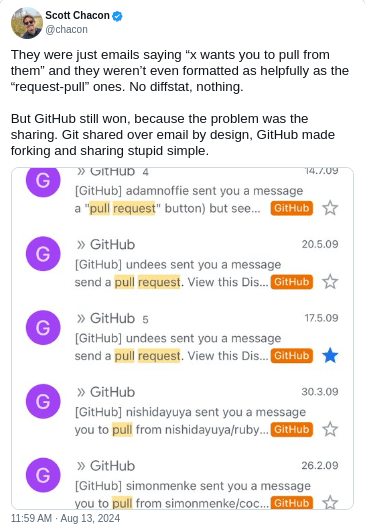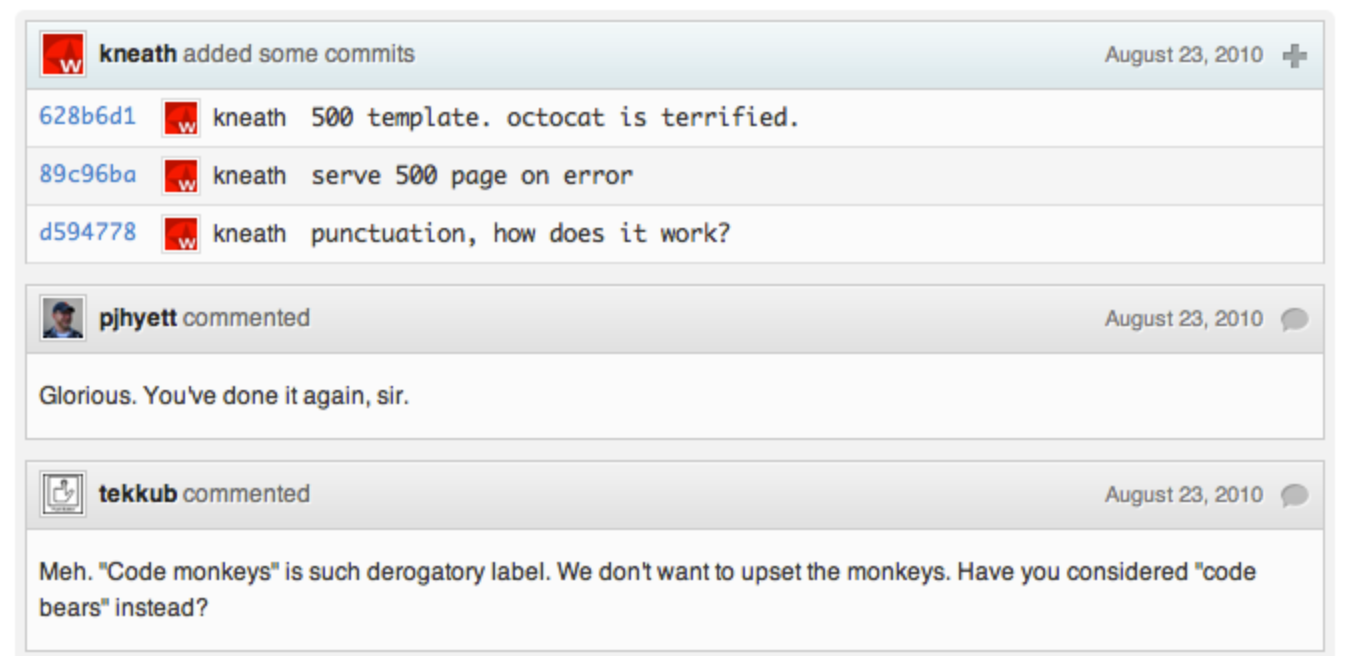GitHub has always been a great code host. But GitHub’s code review system was an afterthought. Even now, Pull Requests still lag behind.
Oh yeah, there’s pull requests now
– GitHub blog, Sat, 23 Feb 2008
When GitHub launched, it had no code review.
GitHub’s Pull Request model—“GitHub flow”—was never designed. It emerged.
But over time Pull Requests became the default way to collaborate via Git, and we’re all still suffering the consequences.
First-generation Pull Requests
GitHub never used git’s built-in git request-pull.
According to Linus Torvalds—Git’s creator—GitHub “decided to replace it with their own totally inferior version.”
When the Pull Request debuted in 2008 it worked like this:
- Create a fork and click “Pull Request.”
- Send a message to someone1 with a link to your fork, asking them to merge it.
But while git request-pull generates a nicely formatted
message with a diff stat and changelog, GitHub hamstrung Pull
Requests.
GitHub provided only a small, empty
<textarea>—Pull Requests were little more than
unstructured emails to other GitHub users.

And Pull Requests still lacked any way to see changes via the web.
“Code Review = Discussion + Code”?
It took two years for GitHub to show the git diff
between two repos on GitHub.
In 2010, “cross repository compare view” coupled with an unthreaded comments section and became Pull Requests 2.02.

Of course, the code and the comments were still on two different pages. It took another year before you could comment in the code.
Inline code comments
In 2011, rtomayko made the first inline comment on a
change, writing, in
full: “+1”.
Inline code review was far from a revelation. Guido van Rossum’s Mondrian—his 20% project at Google—had inline code comments by 2006. And there was an open-source version of Mondrian on the public web by 2008.
The Linux Kernel (using git format-patch) had code comments since 2005.
GitHub’s code review is still behind.
In 2008, GitHub’s developers created a new kind of code review.
But key features were missing. GitHub slowly tacked on these features:
- 2010: Compare view
- 2011: Ignore whitespace changes
- 2016: “Approve”, “Request changes”, and “Start a review”
- 2017: Required review
- 2019: Multiline comments
- 2023: Merge queues
Now, it’s 2024. And here’s a biased list of what I think is still missing:
- Commit review – Ability to comment on the commit message.
- Your turn – Like Gerrit’s attention sets – Microsoft recently did a study on a system called Nudge which was a similar idea, it yielded good results, reducing review completion time 60%.
- User-defined review labels – “Approve”/“Request changes” is so limited—instead of using a complicated system of tags to mark changes ready for design approval, technical writing approval, style approval, and code approval—let repo owners figure out what approvals make sense for their project.
- Hide bot comments – Allow me to hide bot comments so I can see the human comments.
- Push to pull – Push to a special remote to create a
pull request using my commit:
git push origin <branch>:refs/pull-request/<target-branch>. - Review in notes – Annotate commits with metadata in
a special
git
note
refs/notes/review. - Stacked diffs – Just come on. You have infinite money.
And at this point I made Gerrit, but with more branches.
“Someone” was a person chosen by you from a checklist of the people who had also forked this repository at some point.↩︎
“Code Review = Discussion + Code.” was the headline of a blog post GitHub wrote circa 2010 introducing Pull Requests 2.0↩︎